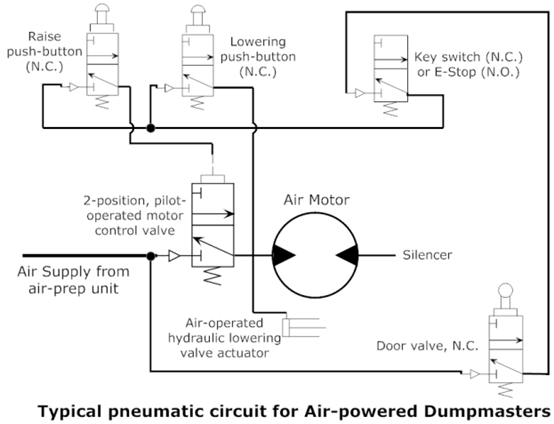Most of Simpro’s product range can be optionally specified with compressed air power instead of battery or mains electricity.
This option is ideally suited to hazardous environments, as an alternative to using explosion-proof electric components. Simpro compressed-air powered machines are typically a little more expensive so it is recommended only when electric equipment cannot be used. They also have to be connected to an air supply while in use.
It is important to understand that the compressed-air is used to power a standard hydraulic system – the compressed air is not used to directly support a load.
General characteristics and performance
The primary differences between standard electric machines and compressed-air powered machines are:
- The electric motor is replaced with an air motor which drives a hydraulic pump which generates hydraulic pressure to lift the load.
- The solenoid-operated lowering valve is replaced with an air-operated lowering valve.
- The electric controls are replaced with air valves which perform identical functions and from the operator’s point of view are exactly the same.
- An ‘Air-prep unit’ (filter/regulator/lubricator) is fitted. This must be checked regularly, the filter bowl drained and the lubricator bowl topped up.
- The machine cannot operate unless it is connected to an air supply.
A check valve holds the pressure when the motor turns off or when the air supply is disconnected. The load cannot come down unless there is sufficient air pressure to operate the lowering valve cylinder.
Air motors have completely different torque and performance characteristics from electric motors.
- The speed of an air motor is directly proportional to the load. 1-phase and 3-phase motors generally maintain the same rpm regardless of the load, and although DC motors may slow down somewhat, they also draw more current when under load.
- The slower an air motor is running, the less power it generates. Electric motors generally draw more current and generate more power when they slow down due to a load applied.
- The speed is directly proportional to the air pressure and flow available. If the flow and/or pressure fluctuates due to other equipment on site, the performance of the Simpro machine may vary accordingly.
The lifting speed of an air-powered bin-tipper or stacker may be slower, especially with loads approaching the maximum rated capacity.
The lowering speed is not affected by the load, and is regulated by an internal pressure-compensating valve.
In order to get maximum performance from the air motor, a clean and dry air supply of at least 35 l/sec at 7 bar (78 cfm at 100psi) is required at the machine. The compressor does not necessarily need to have that much capacity, as air is only used while the motor is actually running, which is only when the load is being lifted. If a reasonably large reservoir is provided close to where the machine will be operating, a compressor with 5 – 7 l/sec (10 – 15cfm) capacity should be adequate.
Ideally the piping from the air reservoir to the machine (including the flexible hose connection) should be at least 13mm ID.
An air-prep unit comprising a filter, pressure-regulator, and lubricator is normally provided with Simpro air-powered equipment. The lubricator should be topped up with oil periodically; the ideal lubrication rate is 8 – 10 drops per minute while the motor is running.
The air motors are fitted with a silencer, and generally have similar noise levels to electric machines.
Maintenance requirements
The only regular maintenance required is to keep the lubricator topped up with oil, and the flow rate adjusted correctly. The filter bowl may also need to be emptied occasionally.
